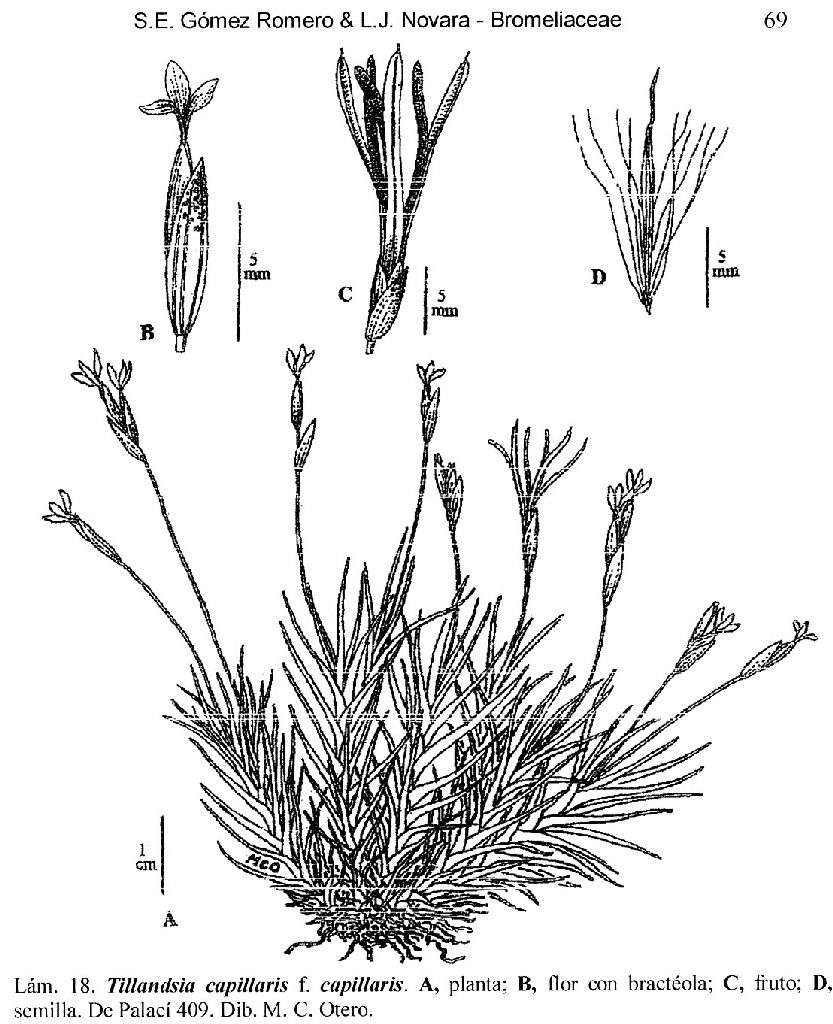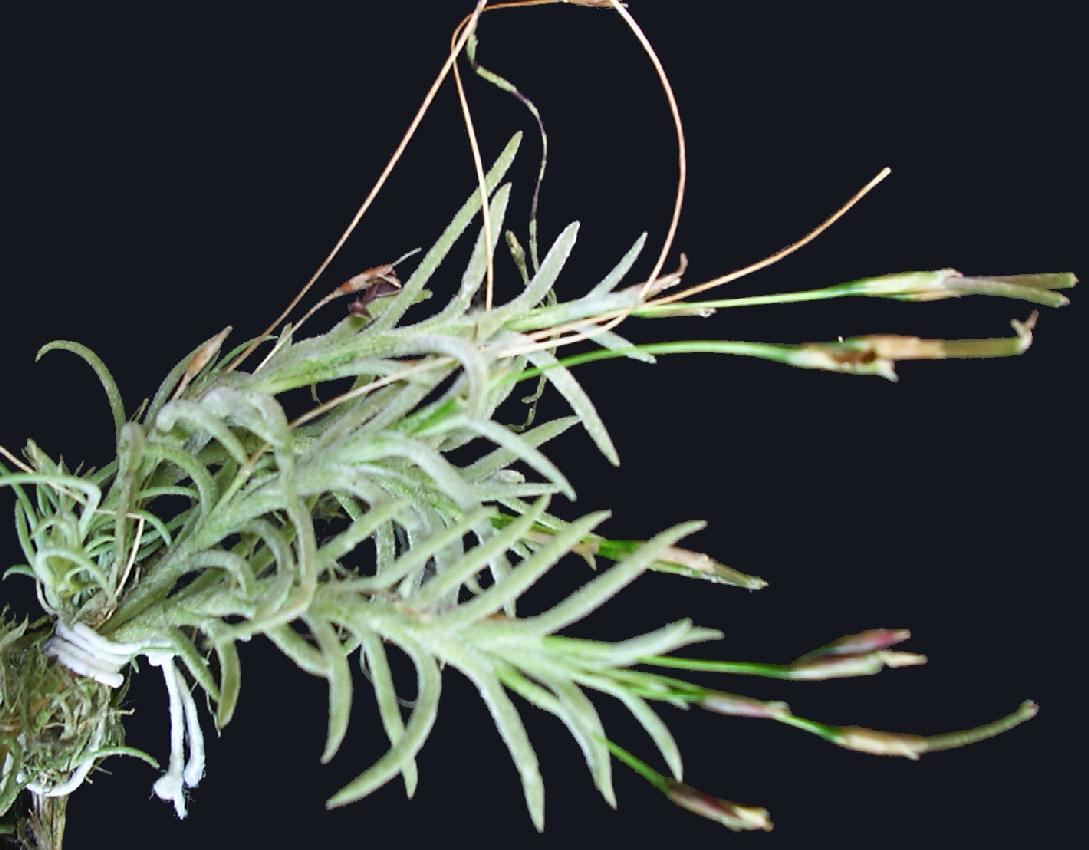
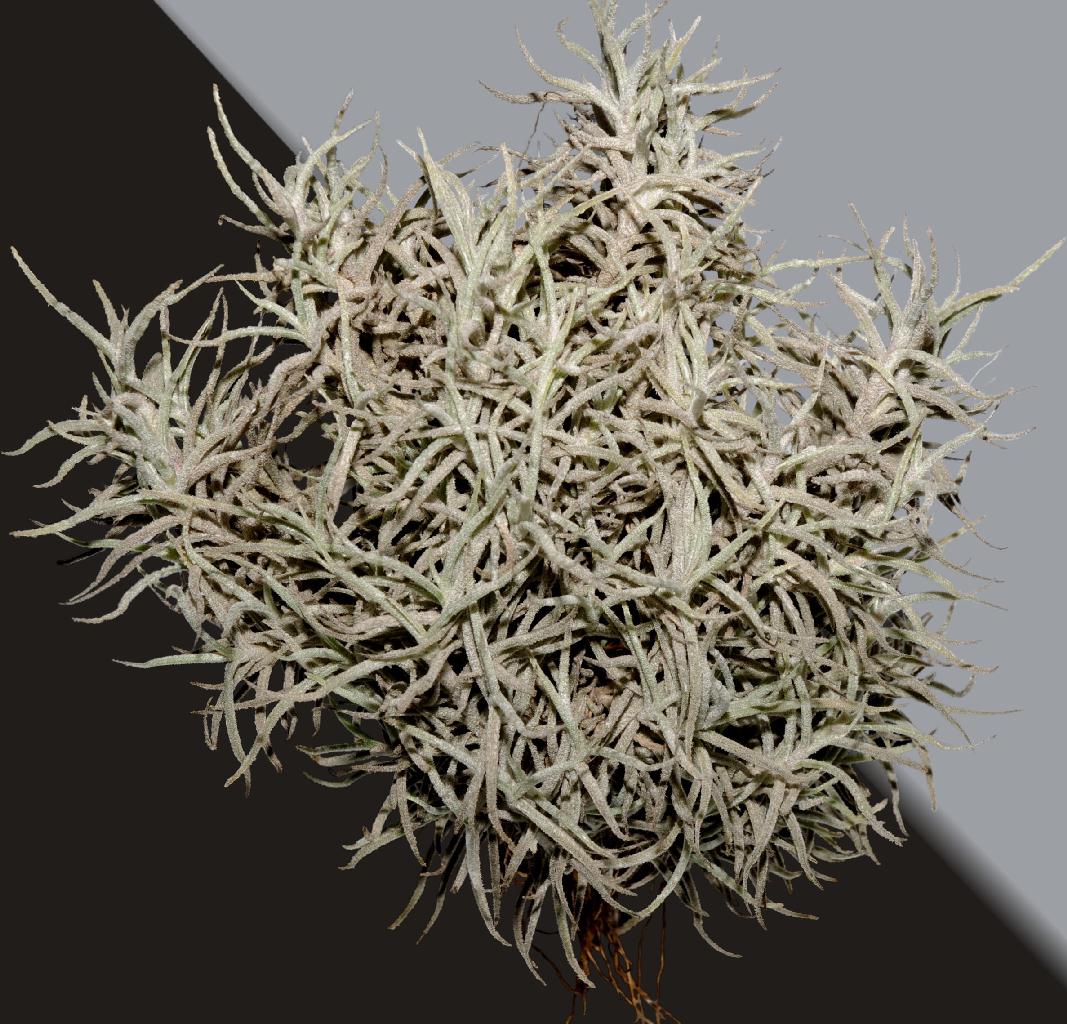
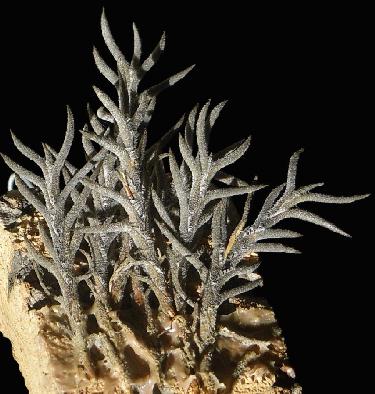
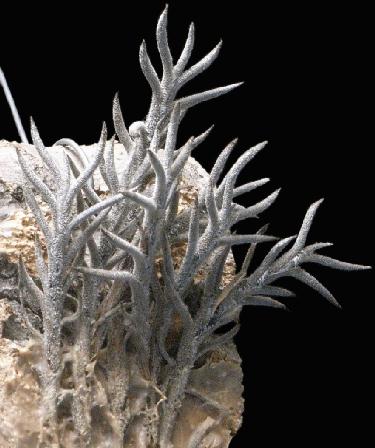
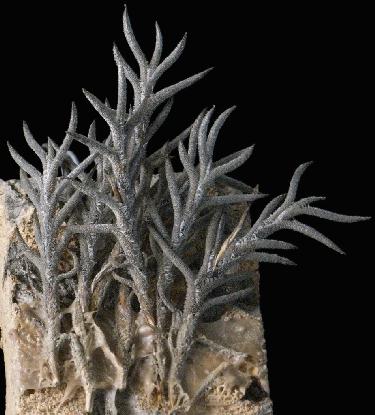

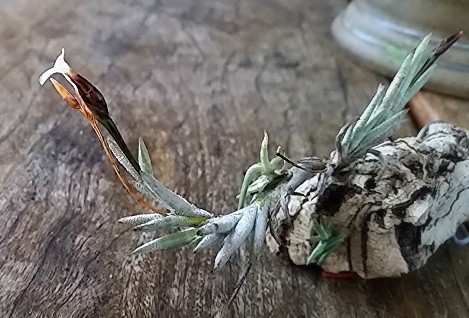
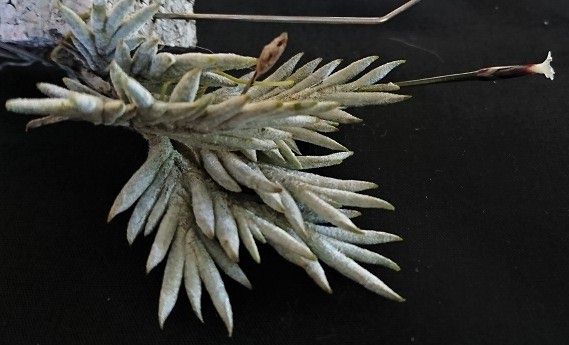

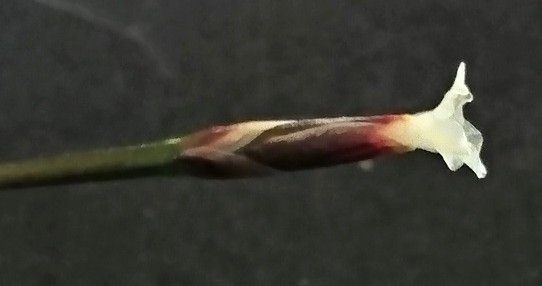
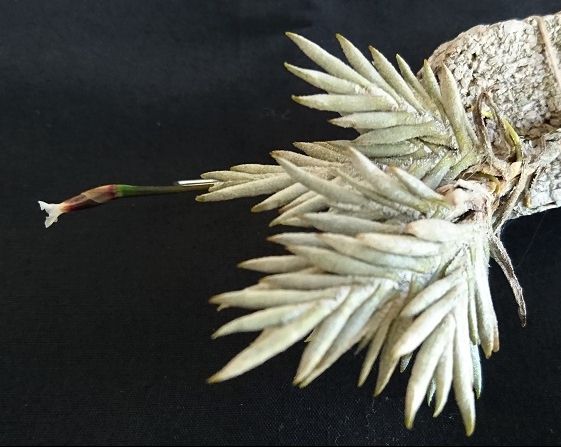
Tillandsia capillaris Ruiz & Pavon, Fl. Peruv. 3: 42, pI. 271,.fig. c. 1802. Note Walter Till split T. virescens from T. capillaris in Die Brom 2/ 1989 Synonyms according to Till
Diaphoranthema capillaris (Ruiz & Payon) Beer, Bromel. 153. 1857.
Tillandsia lanuginose Gillies ex Baker, Jour. Bot. London 16: 237.1878; nomen in synon. Tillandsia capillaris var ß lanuginose Mez, DC. Monogr. Phan. 9: 879. 1896. Type. Mendoza, Argentina, Gillies s n (K, K photo), Sep 1823.
Tillandsia capillaris forma typica L. B. Smith, Proc. Am. Acad. (Contr. Gray Herb. 106) 70: 210. 1935.
Tillandsia capillaris forma incana (Mez) L. B. Smith, Proc. Am. Acad. (Contr. Gray Herb. 106) 70: 211.1935.
Tillandsia incana Gillies ex Baker, Jour. Bot. London 16: 238. 1878; nomen in synon. Based on Gillies s n (K), Mendoza, Argentina.
Tillandsia propinqua Gay var ß saxicola Hieronymus, Icon. & Descript. Argent. 16, pl. 3, fig. 4. 1885. Type. Quebrada del Choro, east of los Gigantes, Sierra Chica, Cordoba, Argentina, Hieronymus s n (B), 4 Dec 1878.
Tillandsia capillaris Ruiz & Pavon var ? incana Mez, DC. Monogr. Phan. 9: 879. 1896.
Tillandsia permutata Castellanos, Lilloa II: 145. 1945. Type. Yacanto, Cordon Central, Cordoba, Argentina, Hauman s n (BA 1573), Ju11920.
Tillandsia pusilla Gillies ex Baker, Jour. Bot. London 16: 237. 1878. Type. Mendoza, Argentina, Gillies s n (K, K photo).
Tillandsia lichenoides Hieronymus, Icon. & Descript. Argent. 17. 1885. Type. Guachipas, Salta, Argentina, Lorentz & Hieronymus 1180 (B, GH photo S), 1873.
Tillandsia hieronymii Mez, DC. Monogr. Phan. 9: 876. 1896.
Tillandsia propinqua sensu Grisebach, Symb. Argent., Gott. Abh. 34: 334. 1879; non Gay, 1853. Based on Hieronymus 124 (B, CORD, F, US), Cordoba, Argentina, 12 Nov 1876.
Description from Till in Die Brom 2/1989: Typical T. capillaris has floral bracts that are nearly round, Sepals stocky and with strongly developed nerve branches, petals linear lanceolate. See drawing
Details from Till Thesis 1984 translated by Butcher
T. capillaris s. l. is divided into 5 groups, are systematically not quite equal. Group 1 (capillarls s. str.) and group 2 (pusilla = hieronymi) seem linked and are close to Group 3 (permutata) and group 4 (incana). Group 3 is also divided into 2 subgroups (a: = permutata and b: HR 5174, WT 909, WT 881, WT 912, WT 977, HR 7101d, HR 5109d, HR = 9120, HR 7187 aff. permutata. This outline is tentative and no taxonomic consequences are drawn. We reserve the right to make further investigations. Group 5, see there!
Group 1. T. capillaris s. str. (incl. lanuginosa and capillaris forma typical; Drawings 55 and 57)
Plant short stemmed, few branched.
Leaves distichous, 3-5 cm long, mostly bent open, ca. 1.5 mm Ø, dense grey scaled;
Sheath scaled in the visible part;
Blade linear awl-like, soft, round in cross section,
Peduncle distinct, 3-5 cm long, glabrous, without bract;
Inflorescence mostly 1-flowered, seldom 2-flowered;
Flower bract suborbicular or ovate rounded, mostly with short blade, glabrous, 7 (-9)-nerved, 4-4.5 (-5.8) mm long, 3.8-4.5 mm wide, (3-) 5 ribbed ( including midrib) near the tip joined together;
Sepals broad lineal, mostly in the middle, seldom above the middle at its widest, the tip wide rounded or seldom blunt tipped, glabrous, the posterior pair to 1/3 connate, anterior shorter connate, 5-nerved, 4.7 -6 mm long, 1.7-2.1 mm wide, seldom with few raphides,
Petals narrow lanceolate to tongue shaped, with round tip, at its broadest at the middle or a little above, 5-nerved, 6.8-8 (-8.8) mm long, 1.2-1.5 (-1.7) mm wide, with raphides, yellow.
Anthers 0.9-1.4 (-1.8) mm long, 0.2-0.25 mm Ø; Filament whitish, basifixed, 1-nerved, 0.1-0.15 mm wide;
Ovary inverted conical cylindric, quickly narrowing to the style, 1.7-2.1 mm long, 0.9-1.1 mm Ø, Style about ½-2/3 as long as the ovary and about 1/3 as wide; Stigma flat capitate, almost as wide as the style, Gynoecium 2.5-2.8 (-3.2) mm long.
Range; SE Ecuador over the Andes to the Andes of Peru and Bolivia and isolated in N Argentina and in Prov. Cordoba.
Group 2: T. pusilla (incl. hieronymi, capillaris forma hieronymi, lichenoides, lichenoides var. hieronymi and propinqua sensu Grisebach 1874) Drawings 58, 60, 61, 63, 65, and 67.
Plant small, short or very short stemmed, 2-7 (-7) cm long
Leaves densely distichous, straight, dense grey scaled
Sheath evidently glabrous or almost glabrous,
Blade round in cross section, 1-1.5 mm Ø, 1-2 (-2.5) cm long, soft
Peduncle missing or very short ( to 1 cm), glabrous,
Inflorescence 1- flowered, very seldom 2-flowered
Flower bracts broad oval, with entirely short blade, glabrous, (3-) 5 (-8)-nerved, (0-) 3 (-4) ribs nearly bundled together at the tip, (3-)4.1-4.8 (-6) mm long, (2.6-) 3.2-3.8 (-4.4) mm wide
Sepals broad lanceolate, rounded at the tip or seldom blunt tipped, glabrous, posterior pair ¼-1/3 connate, anterior somewhat a little connate, 3 (-5)-nerved, widest below the middle, (3.7-) 5-6.2 (-6.9) mm long, (1.3-) 1.5-1,6 mm wide, seldom with a few raphides,
Petals tongue shaped to narrow spoon shaped, broadest in the upper 1/3 ( seldom ± in the middle), tip rounded, 3-5-nerved, (6.8-) 7.9-8.9 (-10.9) mm long, (1-) 1.3-1.5 (-1.7) mm wide, with raphides, yellowish
Anthers 0.9-1.3 (-1.9) mm long, 0.15-0.25 mm Ø, Filament basifixed, whitish, 1-nerved, (2-) 2.6-3.1 (-3.6) mm long, 0.1 mm wide,
Ovary inverted conical cylindrical, quickly narrowing to the style, (1-) 1.5-2 (-2.3) mm long, 0.7-0.9 mm Ø, Style a pillar, ½-2/3 as long as the ovary and about 1/3 as wide, Stigma flat capitate, about as wide as the style; Gynoecium (1.7-) 2.4-2.9 (-3.6) mm long.
Range; Isolated in mid and S Peru, abundant in Central Bolivia and all in N and Mid Argentina
Group 3a: T. permutata ( Drawings 68, 70, 71, 73, 74, 75, and 76)
Plant short or very short stemmed, not or very little branched 1.5! – 10 cm long,
Leaves densely imbricate distichous, straight or a little bent over, not pungent, ± soft;
Sheath ovate, visible portion scaled,
Blade round in cross-section, dense ± appressed scaled, 1.5-2.5 mm Ø, 1-2 cm long
Peduncle almost always missing or at the most very short and glabrous,
Inflorescence 1-2-flowered, mostly at the top
Flower bracts broad oval to suborbicular, with short blade, glabrous, 5-7 (-12)-nerved, (3.5-) 4-5.3 (-6.2) mm long, (3.4-) 4-4.7 (-5.5) mm wide, (0-) 3 (-5) ribbed bundled together at the tip,
Sepals broad lanceolate, mostly clear widest below the middle, the tip broad rounded or blunt tipped, glabrous, posterior pair ¼-1/3 (-1/2) connate, posterior less, sometimes with raphides, (4.7-) 5.7-6.8 (-7.2) mm long, (1.4-) 2-2.6 mm wide
Petals tongue shaped, from base to tip either ± the same width or the upper 1/3 somewhat constricted and with ± broad oval platte or the upper 1/3 in a broad oval platte, the tip rounded, with raphides, (3-) 5 (-7)- nerved, (6.7-) 8.1-10.3 (-11.8) mm long, (1.1-) 1.4-2 (-2.3) mm wide, yellow or seldom light brownish
Anthers (0.9-) 1.2-1.7 (-2.1) mm long, 0.2- 0.4 mm Ø, Filament basifixed (seldom ± basifixed), whitish, 1-nerved, 2.8-3.7 (-4.1) mm long, 0.1-0.15 mm wide;
Ovary rounded inverted ovate cylindric, quickly narrowing to the style, 1.7-2.3 (-2.6) mm long, (0.9-) 1.1-1.3 (-1.6) mm Ø, style sturdy, a pillar, 1/2 (-2/3) as long and about 1/3 as wide as the ovary; Stigma flat, as wide as the style; Gynoecium 2.5 -3.2 (-3.6) mm long.
Range; Isolated in Central and S Bolivia, N to Mid Argentina in the Andes and in the Prov, Buenos Aires
Group 3b; T. aff. permutata ( Drawings 77, 78, and 79)
Plant very similar to Group 3a
Leaves to 3 mm Ø, succulent
Peduncle short
Flower bracts broad ovate, with short blade, widest near the base, glabrous, seldom in the area of the nerves ( or wholely) scaled, often with raphides, (6-) 9-12-nerved, (4.1-) 5-8.2 (-9.2) mm long, (4.5-) 4.8-6.5 (-7.1) mm wide,
Sepals broad lanceolate, blunt tipped or seldom broad rounded, glabrous, with raphides, 1/3-1/2 posterior pair connate, anterior ¼ connate, (5-) 6-8-nerved, (6-) 6.8-10 (-11.2) mm long, (2.2-) 2.5-3 (-3.3) mm wide,
Petals spoon shaped, upper 2/5 a clear long oval platte, the tip broad rounded, with raphides, 5-7-nerved, 10.5-12.8 mm long, 2.5-3.1 (-3.9) mm wide, light violet or white
Anthers (1.3-) 1.8-2.4 mm long, 0.25-0.4 mm Ø, Filament basifixed or almost basifixed, whitish, 1-nerved, (3-) 3.6-4.4 mm long, 0.15 mm wide,
Ovary inverted ovate cylindric, quickly narrowing to style, (1.9-) 2.3-2.7 mm long, (1.3-) 1.5-1.7 (-1.9) mm Ø; Style sturdy, a pillar, ½-2/3 as long and 1/3 as wide as the ovary; Stigma flat, as wide as the style; Gynoecium (3.1-) 3.5-3.9 mm long.
Range; Local in SE Bolivia ( HR5174 and HR 9120) and N Argentina ( Salta, HR7187)
Group 4: T. incana ( incl. capillaris var incana, capillaris forma incana, and propinqua var saxicola) Drawings 64, 72, and 82
Plant short stemmed, 4-7 cm long, almost always branched.
Leaves densely distichous, mostly bent second, bent in front of the stem, 1-1.5 cm long;
Sheath in the visible part scaled
Blade round in cross section, densely ± appressed scaled, 1-1.5 mm Ø;
Peduncle missing or short and glabrous;
Inflorescence almost always 1-flowered;
Flower bracts broad suborbicular, with short blade, glabrous, 5-nerved, (2-) 3 ribs bundled together near the tip, 3.5-4.8 (-7.2) mm long, 3.6-4.4 mm wide,
Sepals broad lanceolate, tip broad rounded, widest at the lower 1/3, glabrous, seldom with raphides, posterior pair ½-2/3 connate, anterior ¼-1/3 connate, 3-5-nerved, 4.5-5 (-7) mm long, 1.6-2.3 mm wide,
Petals tongue shaped, with raphides, the tip broad round, widest mostly in the lower1/3, seldom in the upper 1/3 a little wider, (3-) 5-nerved, 6.3-7.6 (-10) mm long, 1.3-1.8 mm wide, light yellow, seldom with violet flecks;
Anther 1.1-1.5 (-2) mm long, 0.2-0.3 mm Ø, Filament basifixed, whitish, 1-nerved, (2,4-) 2.7-3.1 mm long, 0.1 mm wide;
Ovary inverted conical cylindric, quickly narrowing to the style, 1.5-1.9 mm long, 0.8-1 (-1.3) mm Ø, style a pillar, (1/2-) 2/3 as long and 1/3 as wide as the ovary; Stigma flat, as wide as the style; Gynoecium 2.3-2.8 mm long.
Range; very isolated in Central and S Bolivia, Andes of N and mid Argentina, Sierra de Cordoba and in the Prov. Buenos Aires ( Sierra de Tandil)
Group 5:
This group represents a summary of all documents known to be associated with the smaller previous group, that are heterogeneous. It is a temporary measure.
Peru; Junin, Tarma, 3000-3200 msm, 20.-22. IV. 1929, Killip. & Smith 21785(NY!); Argentina : Tucuman, alrededores de la Ciudad de Tucuman, 26.9. 1922, Venturi s. n. (B!); Jujuy, Capital, 5 km E of Jujuy, 1250 msm, 4.10. 1938, Eyerdam & Beetle 22419 (GH!; left over from Group 2).
Detail from S&D
232. Tillandsia capillaris Ruiz & Pavon, Fl. Peruv. 3: 42, pl. 271, fig. c. 1802.
Plant very variable in both size and form, to 16 cm long in flower; roots present; stems many from a single point, densely massed, simple or branched.
Leaves distichous, mostly 1-4 cm long, rarely shorter or up to 9 cm long, densely and finely pruinose-lepidote with cinereous to ferruginous scales; sheaths usually elliptic, thin, several-nerved, densely lepidote except where covered by the next below; blades erect to spreading, straight or rarely contorted, linear and less that a 2 mm in diameter or narrowly triangular and thicker according to the form represented.
Scape from almost none to 8 cm long, mostly slender, always naked, glabrous or slightly lepidote toward apex, developed almost wholly after anthesis.
Inflorescence normally 1-flowered, rarely 2-flowered.
Floral bracts ovate, acute or apiculate, thin with 3 or more strong nerves, densely lepidote to glabrous, usually equaling or exceeding the sepals;
flowers subsessile.
Sepals lanceolate, acute or obtuse, to 8 mm long, connate posteriorly;
petals narrow with blade scarcely distinct, white, yellow or brown;
stamens deeply included, exceeding the pistil.
Capsule slenderly cylindric, abruptly short-beaked, 10-20 mm long.
Key to the Forms of Tillandsia capillaris
1. Floral bracts with at least 5 strong nerves meeting near the apex. > 2
1. Floral bracts with only 3 strong nerves meeting near the apex, other nerves if any short and with free apices. > forma hieronymi
2. Scape evident after anthesis and mostly exceeding the leaves. > 3
2. Scapes never elongating much even after anthesis, mostly shorter than the leaves. > forma virescens now species
3. Floral bracts glabrous or scantly and deciduously lepidote; scapes conspicuously pseudo-axillary. > 4
3. Floral bracts densely and persistently lepidote; scapes usually but not invariably terminal; leaves widely spaced so that the greater part of each sheath is uncovered. > forma cordobensis now virescens
4. Leaves slender and elongate, not over 2 mm in diameter, obtuse, loose and spreading. > forma capillaris
4. Leaves short and stout, mucronate, appressed and ascending so that they form an almost continuous plane. > forma incana
Tillandsia capillaris forma capillaris
Diaphoranthema capillaris (Ruiz & Pavon) Beer, Bromel. 153. 1857.
Tillandsia lanuginose Gillies ex Baker, Jour. Bot. London 16: 237. 1878; nomen in synon.
Tillandsia capillaris var ß. lanuginosa Mez, DC. Monogr. Phan. 9: 879. 1896. Type. Mendoza, Argentina, Gillies s n (K, K photo), Sep 1823.
Tillandsia capillaris forma typica L. B. Smith, Proc. Am. Acad. (Contr. Gray Herb. 106) 70: 210. 1935.
Leaf-blades slender, elongate.
Scapes pseudo-axillary, elongate.
Floral bracts with 5 or more nerves, glabrous or subglabrous.
TYPE. Ruiz & Pavon s n (isotype BM, GH photo; P), without exact locality, Peru. DISTRIBUTION. Saxicolous and epiphytic, 350-3600 m alt, Peru and Bolivia to Chile and Argentina.
Tillandsia capillaris forma incana (Mez) L. B. Smith, Proc. Am. Acad. (Contr. Gray Herb. 106) 70: 211. 1935.
Tillandsia incana Gillies ex Baker, Jour. Bot. London 16: 238. 1878; nomen in synon. Based on Gillies s n (K), Mendoza, Argentina.
Tillandsia propinqua Gay var ß saxicola Hieronymus, Icon. & Descript. Argent. 16, pl. 3, fig. 4. 1885. Type Quebrada del Choro, east of los Gigantes, Sierra Chica, Cordoba, Argentina, Hieronymus s n (B), 4 Dec 1878.
Tillandsia capillaris Ruiz & Pavon var ? incana Mez, DC. Monogr. Phan. 9: 879. 1896. Tillandsia permutata Castellanos, Lilloa 11: 145. 1945. Type. Yacanto, Cordon Central, Cordoba, Argentina, Hauman s n (BA 1573), Jul 1920.
Leaf-blades short and stout, mucronate, appressed and ascending so that they form an almost continuous plane.
Scapes evident after anthesis and mostly exceeding the leaves, pseudo-axillary.
Floral bracts with at least 5 strong nerves meeting near the apex, glabrous or subglabrous.
TYPE. Gillies s n (K, K photo), foot of the cordillera near Mendoza, Argentina. DISTRIBUTION. Saxicolous and epiphytic in dry habitats, 786-4000 m alt, Bolivia. northwestern Argentina.
Tillandsia capillaris forma cordobensis (Hieronymus) L. B. Smith, Proc. Am. Acad. (Contr. Gray Herb. 106) 70: 211. 1935. now species virescens
Tillandsia cordobensis Hieronymus, Icon. & Descript. Argent. 10, pl. 3, fig. 1. 1885.
Tillandsia recurvata sensu Grisebach, Pl. Lorentz., Gott. Abh. 19: 225. 1874; non Linnaeus, 1762.
Leaves widely spaced so that the greater part of each sheath is uncovered.
Scapes evident after anthesis, usually terminal, mostly exceeding the leaves.
Floral bracts with at least 5 strong nerves meeting near the apex, densely and persistently lepidote.
TYPE. Hieronymus 349 (holotype B, B photo 1191/16; isotype, CORD), Sierra Achala, Cordoba, Argentina, 1875.
DISTRIBUTION. Epiphytic in dry habitats, 900-3000 m alt, Peru, Bolivia, Chile, Argen-tina.
Tillandsia capillaris forma virescens (Ruiz & Pavon) L. B. Smith, Proc. Am. Acad. (Contr. Gray Herb. 106) 70: 212. 1935. now species
Tillandsia virescens Ruiz & Pavon, Fl. Peruv. 3: 43, pl. 270, fig. b. 1802.
Tillandsia propinqua Gay, Fl. Chil. 6: 15. 1853. Type. Coquimbo, Chile, Gay s n (P, GH photo).
Diaphoranthema virescens (Ruiz & Pavon) Beer, Bromel. 154. 1857.
Tillandsia pusilla Gillies ex Baker, Jour. Bot. London 16: 237. 1878. Type. Mendoza, Argentina, Gillies s n (K, K photo).
Tillandsia lichenoides Hieronymus, Icon. & Descript. Argent. 17. 1885. Type. Guachipas, Salta, Argentina, Lorentz & Hieronymus 1180 (B, GH photo; S), 1873.
Tillandsia stolpi Philippi, Anal. Univ. Chile 91: 614. 1895. Type. Naltagua, Victoria, O'Higgins, Chile, Stolp s n (SGO, GH photo), 1888.
Tillandsia williamsii Rusby, Bull. N. Y. Bot. Gard. 6: 489. 1910. Type. Yura, Arequipa, Peru, R. S. Williams 2539 (NY), 11 Aug 1901.
Tillandsia dependens var sanzini Hicken, Physis 1: 388. 1914. Type. Precordillera, Mendoza, Argentina, Sanzin s n (SI 382), 2 Nov 1913.
Tillandsia virescens var sanzinii (Hicken) Castellanos, Gen. & Sp. Pl. Argent. 3: 337. 1945.
Tillandsia hieronymi var lichenoides (Hieronymus) Castellanos, Gen. & Sp. Pl. Argent. 3: 343. 1945.
Scapes never elongating much even after anthesis.
Floral bracts with at least 5 strong nerves meeting near the apex.
TYPE. Ruiz & Pavon s n (holotype MA n v, isotype F), Huanuco, Peru.
DISTRIBUTION. Saxicolous and epiphytic in dry habitats, 500-4000 m alt, Peru, Bolivia, Chile, and Argentina.
Tillandsia capillaris forma hieronymii (Mez) L. B. Smith, Proc. Am. Acad. (Contr. Gray Herb. 106) 70: 213. 1935.
Tillandsia hieronymii Mez, DC. Monogr. Phan. 9: 876. 1896.
Tillandsia propinqua sensu Grisebach, Symb. Argent., Gott. Abh. 34: 334. 1879; non Gay, 1853. Based on Hieronymus 124 (B, CORD, F, US), Cordoba, Argentina, 12 Nov 1876.
Tillandsia dependens Hieronymus ex Mez, DC. Monogr. Phan. 9: 880. 1896. Type. Sierra Achala, Cordoba, Argentina, Hieronymus 781 (B, CORD, F, US), 30 Jan 1877.
Tillandsia dependens var a perusneoides Mez, DC. Monogr. Phan. 9: 881. 1896; the typical variety.
Tillandsia dependens var ß percordobensis Mez, DC. Monogr. Phan. 9: 881. 1896.
Type. Sierra de Cordoba, Cordoba, Argentina, Hieronymus 352 (B, F photo 11491; CORD).
Tillandsia dependens forma perusneoides (Mez) Castellanos, An. Mus. Nac; Hist. Nat. Buenos Aires 37: 500. 1933.
Tillandsia dependens forma percordobensis (Mez) Castellanos, An. Mus. Nac. Hist. Nat. Buenos Aires 37: 500. 1933.
Floral bracts with only 3 strong nerves meeting near the apex, other nerves if any short and with free apices.
TYPE. Hieronymus 124 (holotype B, isotypes CORD, F, G, GH, GOET, M, US), Cordoba, Argentina, 12 Nov 1876.
DISTRIBUTION. Epiphytic in dry habitats, 300-3600 m alt, Bolivia and northwestern Argentina.
Detail from Baker 1889
4. T. PUSILLA Gillies ; Baker in Journ. Bot. 1878, 237.
Leafy stems tufted, simple, an inch long. Leaves laxly placed on the stem, terete from a clasping lanceolate base, ¼-? in. long, spreading, recurved, not tapering to a slender point, densely lepidote all over. Flowers solitary, sessile. Flower-bracts and sepals ¼ in. long, the former lepidote, the latter naked.
Hab. Mendoza, on bushes, Gillies !Near T. propinqua.
Tillandsia permutata Castellanos, Lilloa II: 145. 1945. Type. Yacanto, Cordon Central, Cordoba, Argentina, Hauman s n (BA 1573), Jul1920.
Syn . T. capillaris R. et P. var. incana Mez non Gilles
Diaphoranthema caespitosa, multicaulis ca 10cm longa; folia brevia ca 15mm longa, grisea, optime disticha erectaque et propterea caulibus aspectum flabellatum praestantia, basi vaginante glabraque, et limbo ca 10mm longo, tereti cum apice acumine abrupte finito, crassa magis 2mm diam. et lepidibus imbricatis conspiquisque dense furfuracea.
Inflorescentia 1-flora (rarissime 2-flora); bracteola conchata, glaberrima, cum mucrone lepidoto ca 5.5 mm longa, 4mm lata, 5 nervis bene ecolutis et 2 lateralibus imperfectis instructa. Flores ca 9mm longi sepalis concavis 7mm longis, glaberrimis, quorum anterius librum et posteriora exceptis 3 mm terminalibus connata. Petala linguiformia ca 8mm longa.
Fructus cylindrici, arcuati ca 22mm longi, 1.5mm dain, multi-seminati; semina fusiformia, castanea, 3mm longa
Spec. ex – Cordoba: Cordon Central, Yacanto W., leg. Hauman VII 1920, B. A. no 1573 typus; Sierra Achala inter Tanti Cuchi del Rosario et Rio Juspe, leg. Hieronymus, det. Mez sub T. capillaris var incana
Drawings from Walter Till.
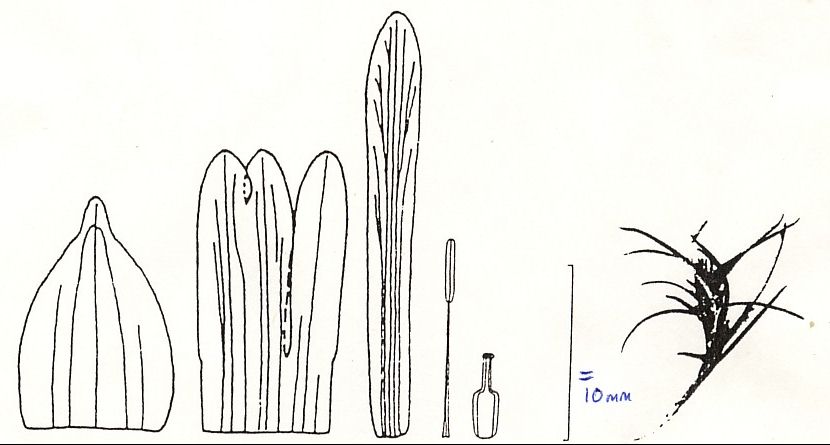
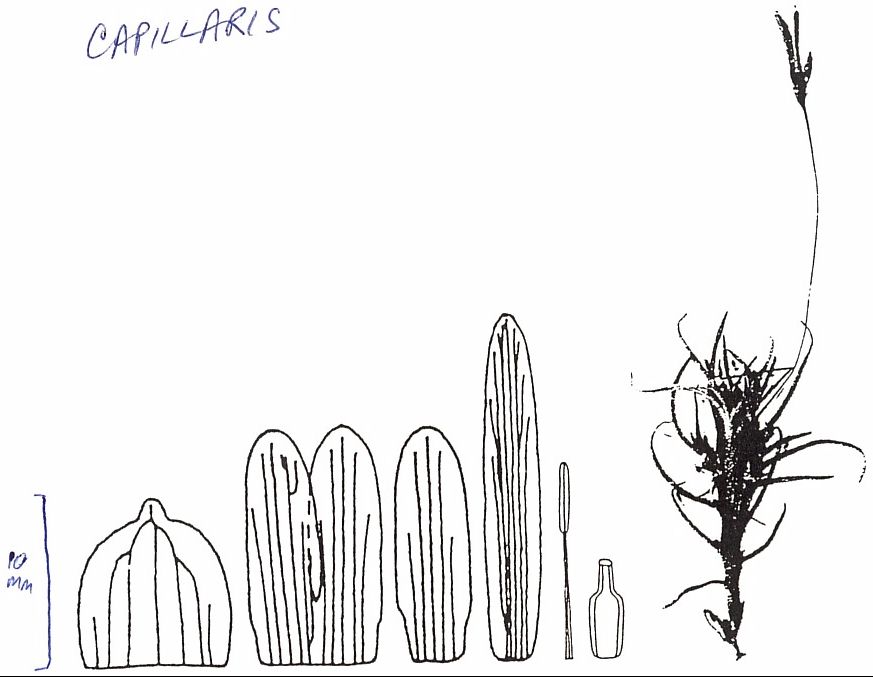
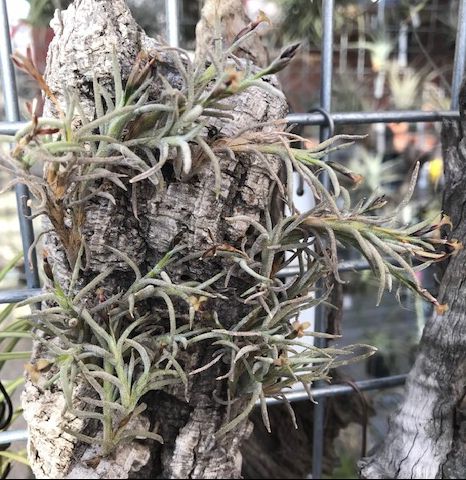
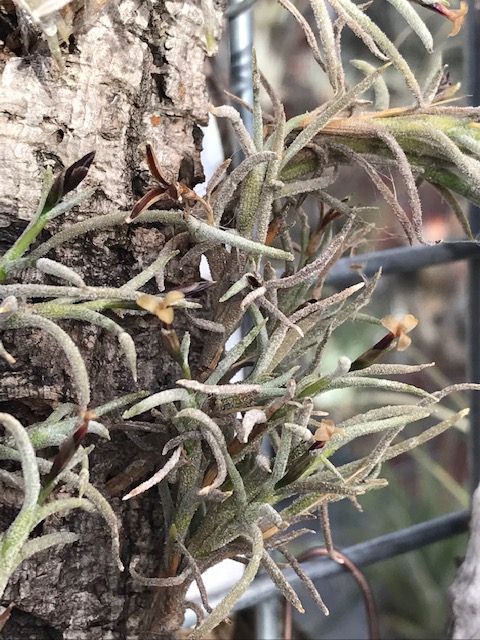
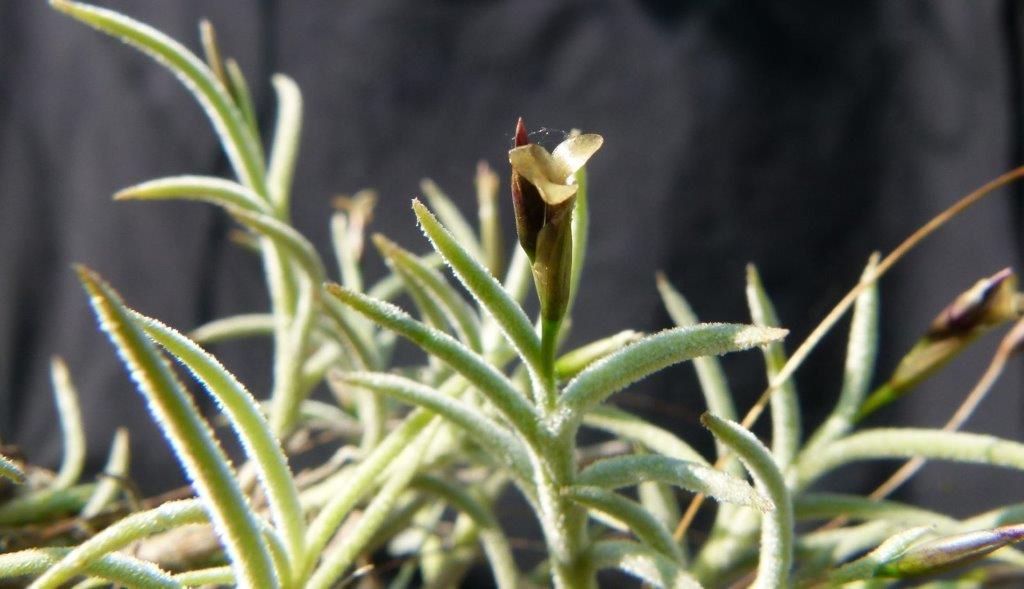
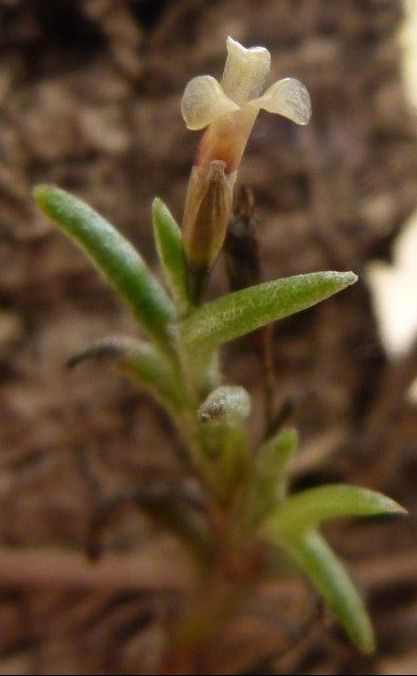
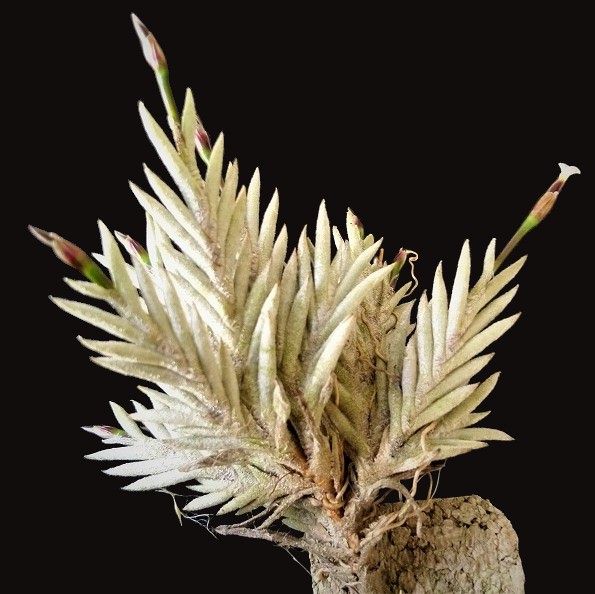
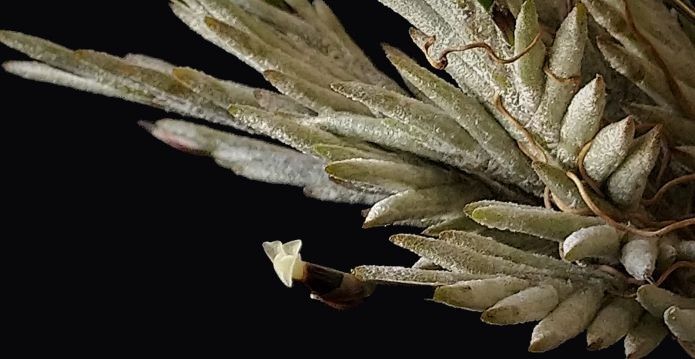

Tillandsia capillaris Ruiz & Pav. See Gomez Romero & Novara in Bromeliaceae Juss 9(7): 64-75. 2010 - Translated by Derek Butcher
(=T. permutata A.Cast.; =T. pusilla Gillies ex Baker; =T. virescens Ruiz & Pav.; =T. cordobensis Hieron . ; =T. hieronymi Mez; =T. lanuginosa Gillies ex Baker)
Herb pulvinate with stems densely branched, elongated, 20-100 mm long, completely covered by leaf sheaths.
Leaves distichous, alternate, sheath glabrous at base, 30-40 mm long, covered at the base by the lower leaf sheath;
Blade straight or curved, attenuated and acute at apex, lepidote.
Peduncle linear, glabrous, hairless, exceeding the leaves, 20-40 mm long x 0.7-1.0 mm wide.
Inflorescence l-2-flowered, with basal bracteola concave, with nerves parallel-curvate, glabrous at the base, lepidote at apex, 8 mm long. x 4-5 mm wide.
Sepals free, glabrous, 8 mm long.
Stamens inserted in the petals, 5 mm long.; Anthers 1.5-2.0 mm long.
Ovary ellipsoid, 2 mm long, narrow at the apex in a short style; stigma trilobed.
Capsule cylindrical, hooked, 12 mm long, x 2 mm wide.
Seeds with long hairs.
Uses: The leaves are cited with stimulant tonic properties, and possibly as a cordial, astringent and healing wounds (Filippa, 2006:119; Barboza et al. 2009: 54).
This species, Smith & Downs (1977), who we follow here, recognizes 5 forms, all of them in the province of Salta and the Lerma Valley. Highly variable, with extreme forms not always easy to identify, the authors distinguish them by the following key (slightly modified):
Tillandsia capillaris f. capillaris
(=T. capillaris Ruiz & Pav. var. lanuginosa Mez; = T. capillaris Ruiz & Pav. f. typica L.B.Sm.; =T. lanuginosa Gillies ex Baker)
Tillandsia capillaris f. incana (Mez) L.B. Sm.
(=T. incana Gillies ex Baker; =T. permutata A.Cast.)
Tillandsia capillaris f. virescens (Ruiz & Pav.) L.B.Sm.
(=T. virescens Ruiz & Pav.; =T. propinqua Gay; =T. pusilla Gillies ex Baker; =T. virescens Ruiz & Pav. var. sanzinii (Hicken) A.Cast.)
Tillandsia capillaris f. hieronymi (Mez) L.B.Sm.
(=T. hieronymi Mez; =T. dependens Hieron. ex Mez. =T. dependens Hieron. ex Mez f. percordobensis (Mez) A.Cast.; =T. dependens Hieron. ex Mez f. perusneoides (Mez) A.Cast.
A Floral bracts with 5 major nerves that are grouped near the apex ==> B
AA Floral bracts 3 major nerves ==> forma hieronymi
B. Peduncle elongated, exceeding the leaves after anthesis ==> C
BB. Peduncle very short, shorter or barely exceeding leaves after anthesis, shorter than leaves ==> forma virescens
C. Bracteoles glabrous and glossy, rarely with few scales promptly deciduous. Peduncle floriferous in pseudoaxilles ==> D
CC Bracteoles with dense, persistent scales. Peduncle often floriferous terminally ==> forma cordobensis
D. Leaves narrow and long, up to 2 mm wide, upper part attenuate and separated from ==> forma capillaris
DD Leaves short and robust, more than 2 mm wide, mucronate, uniformly distributed in a continuous plane along the stem ==> forma incana
Tillandsia capillaris f. capillaris
(=T. capillaris Ruiz & Pav. var. lanuginosa Mez; = T. capillaris Ruiz & Pav. f. typica L.B.Sm.; =T. lanuginosa Gillies ex Baker)
Saxicolous or epiphytic with leaf blade thin and elongated, 15-25 mm long. x l-2 mm wide.
Peduncle thin, almost threadlike, lateral and much exceeding the leaves.
Inflorescence 1 (- 2) flowered, with basal bracteola promptly glabrous or with few scales towards the apex.
Peru, Bolivia, Northern and central Chile, Paraguay, Uruguay, Northwest and centre of Argentina, from Jujuy to Cordoba and Mendoza. Common in almost all of the Valley of Lerma.
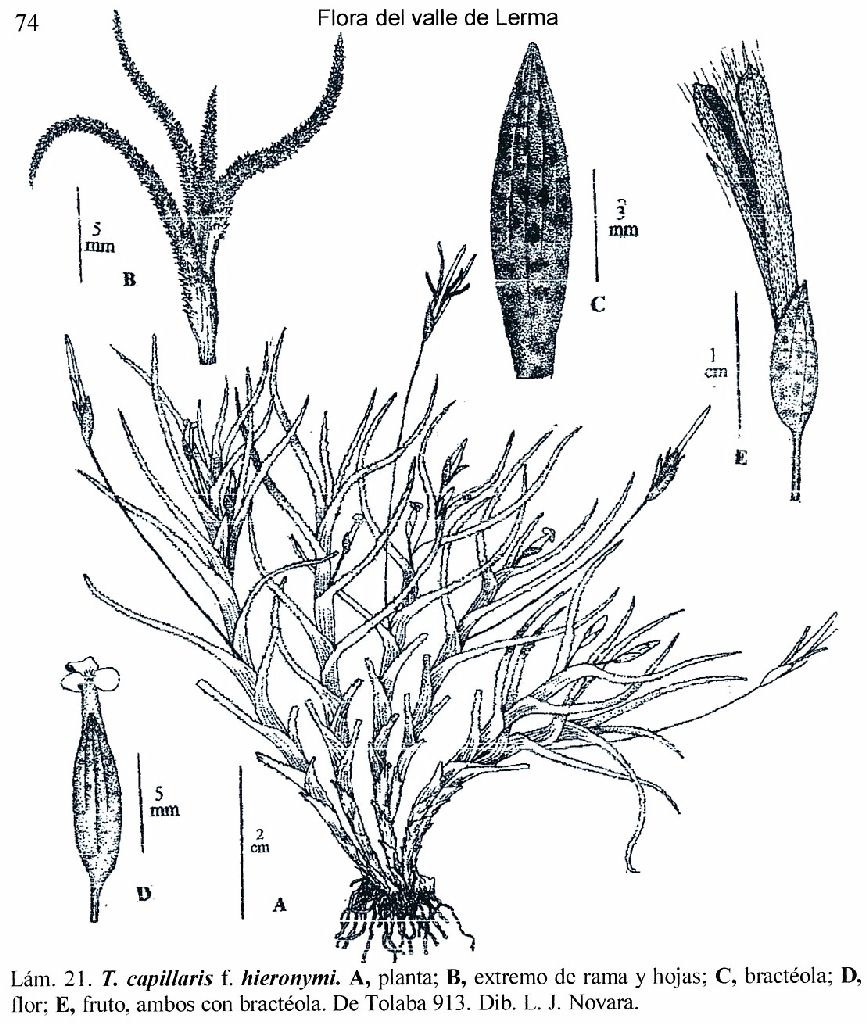
Tillandsia capillaris f. incana (Mez) L.B. Sm.
(=T. incana Gillies ex Baker; =T. permutata A.Cast.)
Leaves numerous, alternate, distichous, flabellate appearance, with leaf blade short and wide, cylindric-conical, 10 mm long x 2 mm wide, apically mucronate, sometimes hooked to claw-like.
Peduncle slender, to filiform, exceeding the apex of the leaves.
Bracts persistent with adaxial scales and 5 main nerves continuous to the apex, notoriously on the underside.
Inflorescence 1 (- 2) flowered.
Saxicolous and epiphytic in dry climates to semi-arid of the Center and South of Bolivia (Potosi, Cochabamba, La Paz), Northwest and centre of Argentina from Salta and Jujuy to Cordoba and Mendoza. Puna of Salta, rare down dry ravines to over 2500 m, to the West of the Valley of Lerma.
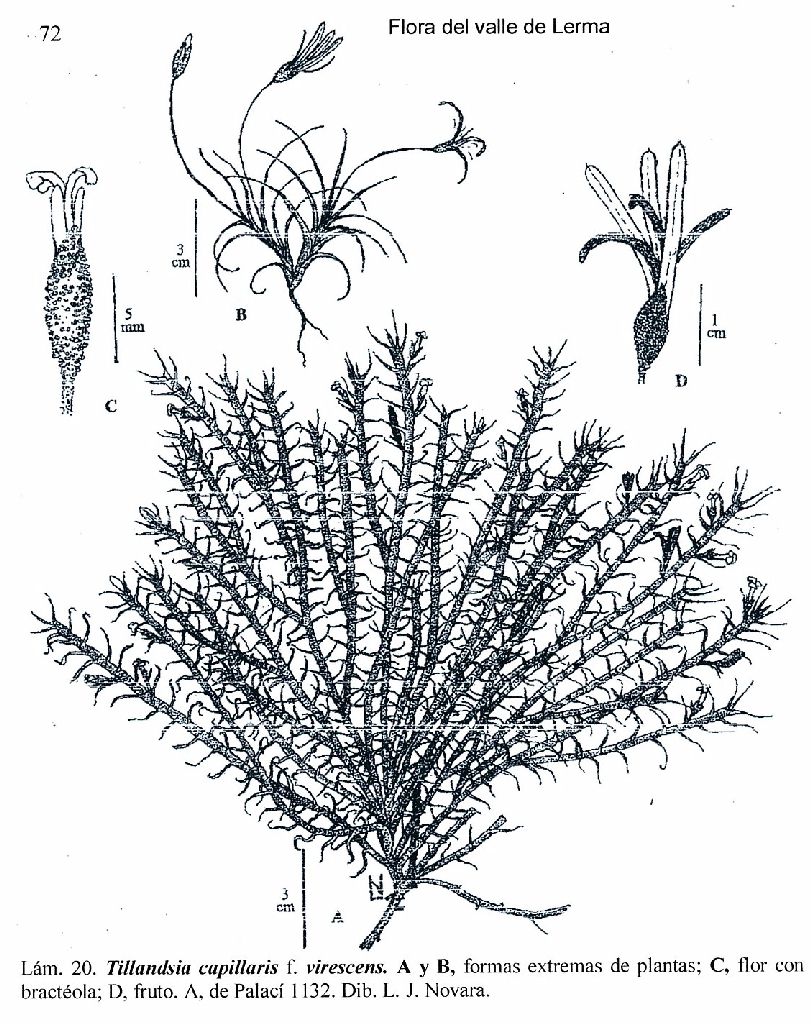
Tillandsia capillaris f. cordobensis (Hieron.) L.B.Sm.
(=T. cordobensis Hieron. ).
Leaves distichous with leaf blade lax and elongated, Apex subulate, 40-60 mm long. x l mm wide.
Peduncle very thin, almost threadlike, almost always topped in a solitary flower.
Floral bract lepidote, persistent scales on the back, 5-nerved on the underside.
Peru, Bolivia and Northwest Argentina to Buenos Aires, San Luis and Córdoba, where the type comes from. In Salta is frequent in the Calchaquí valleys and scarce in southern dry section of the Lerma valley.
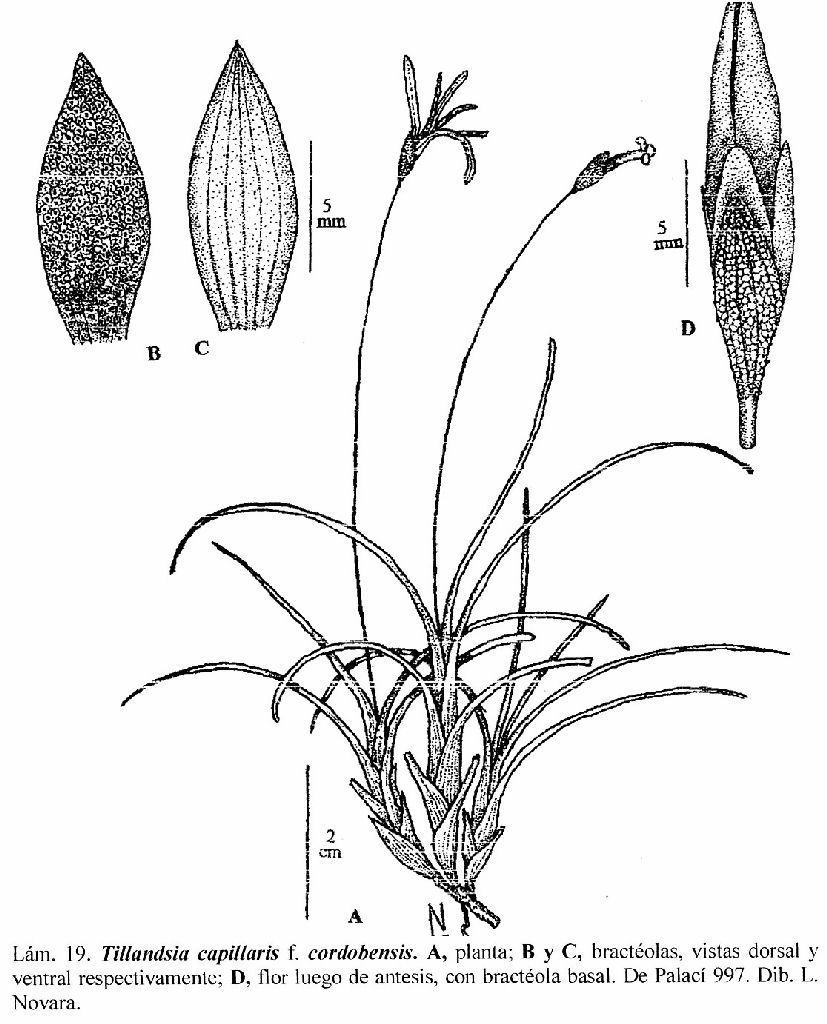
Tillandsia capillaris f. virescens (Ruiz & Pav.) L.B.Sm.
(=T. virescens Ruiz & Pav.; =T. propinqua Gay; =T. pusilla Gillies ex Baker; =T. virescens Ruiz & Pav. var. sanzinii (Hicken) A.Cast.).
Vegetative stems elongated, 10-100 mm long, covered entirely by the leaf sheaths of 5-30 alternate leaves, distichous, flabellate, arranged in a plane.
Leaf blade distichous, spaced apart, 15-20 mm long x 1.0-1.5 mm wide.
Peduncle very short, inserted between the sheaths of upper leaves or barely rising above these.
Epiphyte or saxicolous in dry environments of Peru, Bolivia, northern Chile and Argentina, from Jujuy to Mendoza and Córdoba. Common in the north and center of the Lerma Valley. This species is the variety that is found in environments more humid to the north and center of the Lerma Valley.

Tillandsia capillaris f. hieronymi (Mez) L.B.Sm.
(=T. hieronymi Mez; =T. dependens Hieron. ex Mez. =T. dependens Hieron. ex Mez f. percordobensis (Mez) A.Cast.; = T. dependens Hieron. ex Mez f. perusneoides (Mez) A.Cast.
Leaves with short blade, cylindric-conical, 10 mm long x 1 mm wide.
Bracteóles with 3 continuous central major nerves that come together and meeting near the apex, secondary lateral nerves shorter, that do not reach the end of the bract, more noticeable on the underside.
Dry to subhumid places in Bolivia and Northwest Argentina to Cordoba and Mendoza. Like forma virescens, it lives in the North and centre of the Valley of Lerma, where it is relatively common.
